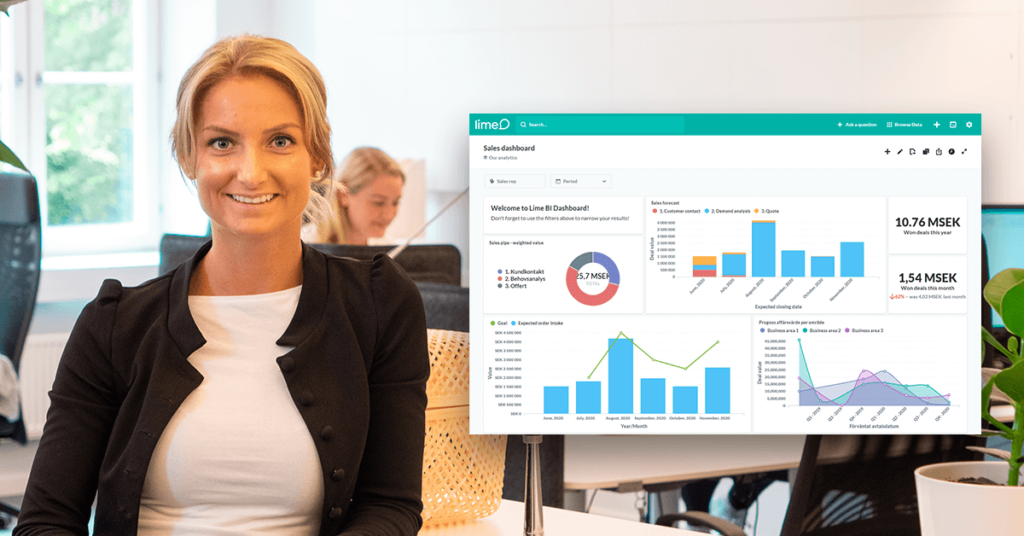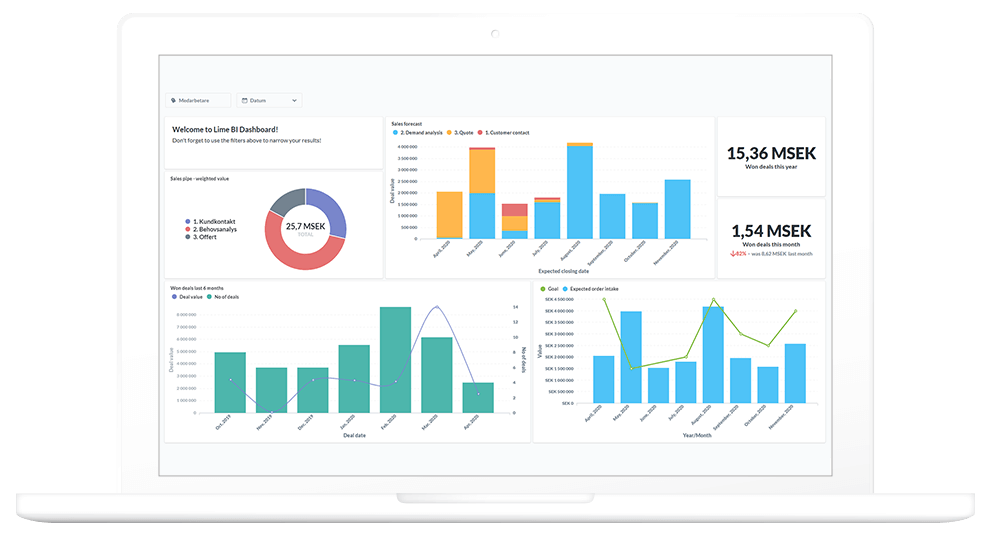Business Intelligence challenges information overload

The digital revolution has made it easier than ever for businesses to collect valuable data. In fact, it’s become so easy to do so that a new problem has been created! How do you interpret the great amount of information now available to you? Many types of organisations have no idea about the amount of data they’re sitting on or how they can use it to their advantage. That’s why Business Intelligence (BI) has emerged as the favorite tool for most organisations when they need to use data to do informed decisions. But what is Business Intelligence, and how is it used?
Do you want more information about Lime BI and how it works?
Business intelligence transforms data into insights
Business intelligence is an umbrella term that refers to a number of methods and processes used to collect, structure and analyse data. BI can include everything from business analysis and measurement data to visualisation of that data. With the right business intelligence tools you can get insights into what works better or worse for your business, which helps you create ways of working for your business that is can be more proactive than reactive.
What distinguishes modern business intelligence from traditional business intelligence?
To some people, the concept of business intelligence may feel like it’s unnecessarily complicated. But in reality there’s a simple explanation as to its meaning. The term business intelligence was coined in 1865 and first used in a modern setting in 1958, but developments in the field since then have been enormous.We collect and analyse data today in entirely different ways than ever before, that’s why it’s become more common to hear people talk about traditional business intelligence and modern business intelligence.
Modern business intelligence (BI) has evolved significantly from traditional BI systems, offering a more agile, user-friendly, and comprehensive approach to data analysis and decision-making. So how do they differ between each other? Here’s five ways:
Data Sources and Integration
Traditional BI is usually focused on structured data sources such as databases and spreadsheets. Instead, modern BI handles a broader range of data sources including structured, semi-structured and unstructured data from various sources such as social media, a CRM system or cloud applications for instance. In other words, modern BI emphasises seamless data integration from multiple sources.
Data Storage
Traditional BI often relies on data warehousing, where all the data is stored in a structured manner and accessed through queries to the data warehouse. Modern BI embraces more flexible data storage that allows for handling of large volumes of different data types.
Accessibility
Traditional BI is mainly used by IT specialists or data analysts due to the complexity of the systems needed. It requires a higher technical expertise to be effective. Modern BI emphasises self-service analytics, making data accessible to a wider range of users, everything from the sales manager to the project lead or just someone working as a salesman would be examples of users. Modern BI usually have more user-friendly interfaces with drag-and-drop tools and intuitive dashboards that enables more non-technical users to analyse and gain insights from the data available.
Real-Time Analytics
Traditional BI is often processed in batches, where the data is analysed at regular intervals. That might mean a change has occurred before the processing of the batched data, meaning you could miss out on important information needed for making a decision. Modern BI focuses instead on real-time or near real-time analytics, providing insights and updates on the data as it occur. This allows for a more agile and responsive decision-making.
Scalability and Flexibility
Traditional BI can sometimes be less adaptable to changes and scaling which often requires significant restructuring or reconfiguration of the solution to work as intended. Modern BI offers a more scalable and adaptable approach to your changing business needs. Cloud-based solutions and agile methodologies makes it easier to scale and customise your solution to your ever changing needs.
In other words, traditional BI still exists in some organisations, but it’s usually inefficient and more time consuming compared to modern BI. Modern BI aims to be a “self-service” kind of BI that allows everyone in the business to access answers to their questions about various initiatives and activities with ease. With modern BI, you can follow-up any changes on the go, and statistics are presented on a visual dashboard that makes complex information easy to understand. This makes identifying business opportunities faster, using data as a basis for all decisions the company makes.
More people are benefiting from business intelligence
Business intelligence puts businesses’ raw data in context. What does that mean? Well, depending on what information you’re after, with a modern BI tool, you can ask your own questions on how different business practices have performed or are performing and get answers instantly. These insights can lead you to do either a simple follow-up operation or more in-depth data analysis. Modern BI can enlighten you on everything from finances to marketing to customer service. Has our latest sales activity generated more leads than before? Did our product launch not go as planned? Which communication channels work better or worse than others for our business? A BI tool allows you to gain real understanding and takes the guesswork out of decision-making. Also, BI tools can often be directly integrated into your existing business systems as little dashboards so that your follow-up operations are as frictionless as possible. Simply put, BI makes everyday life easier for everyone in your company, regardless of their position or the size of the team.
Decision-making that’s driven by data
Most people agree that the best kind decisions are made based on facts and not assumptions. This is where business intelligence comes in, making sure decisions are based on factual information and not a gut feeling. Of course, having visual dashboards and reports doesn’t mean it’s a ready-made solutions to all of your challenges. But they do make it easier to interpret important information and data which creates the right kind of conditions for you to make better decisions. Because who doesn’t want to make sure they keep doing more of what works well and less of what doesn’t?
The reasons why more and more organisations are embracing data-driven decision-making are in other words many. Using business intelligence often increases your profitability, lowers cost and helps you gain a better understanding of your market. But don’t take our word for it! A study by McKinsey Global Institute showed that data-driven organisations are 23 times more likely to acquire customers, 6 times more likely to retain customers, and 19 times more likely to become profitable than their non-data-driven counterparts.

Lime BI Analyze is designed to help businesses grow with the help of data-driven insights, no matter what industry they’re in or who in the company uses it. Discover new opportunities, follow market trends and be more prepared for change.
Do you want more business insights?
There’s no time to waste! Let’s find the solution that will help you get more customers and turn existing ones into loyal ambassadors today.